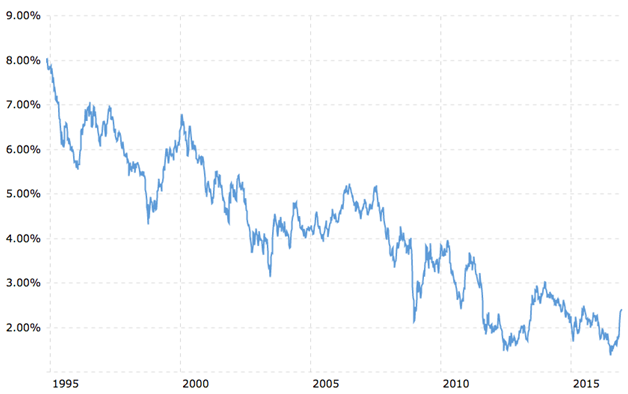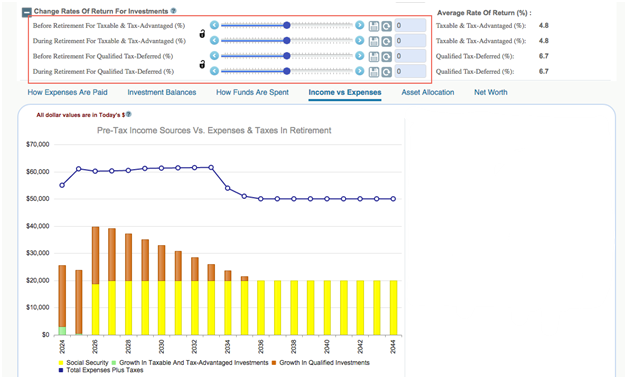Key Points
- If you do not have enough income in retirement to cover expenses, the odds are much higher you will run out of money.
- With treasury yields still historically low, investing in bonds for income will not cut it.
- Solid dividend payers and REITs are a strategy that can pay off for years and year.
If you're retired, or close to it, you probably know the story. Income--especially guaranteed income--is hard to come by these days. 10-year treasuries yielded 2.3% at the end of November of this year. Ten years ago, that number was nearly double, at 4.5%; 20 years ago, it was 6.1%.

Historical 10-Year Treasury Bill Rates
Source: Macrotrends
This is, in short, a big deal. Say you've got about $1 million in invested assets and are living on $65,000 per year. Ten years ago, a million-dollar portfolio, invested entirely in about as risk-free an asset as you could find, would cover about 70% of your living expenses. Social Security would have covered another big chunk of it, and drawing down--by sipping, not gulping--on the principal would have covered the rest.
Fast forward to today. That treasury-bill investment would only generate about $23,000 per year, or about a third of what you'll need to live on.

With WealthTrace, you can see how changes to asset classes, spending, and expenses can lead to big changes in a retirement plan's success. Above: The difference between investing in low-yielding treasury bills and higher-yielding dividend-paying stocks. The line represents total expenses, and the bars represent income sources. There's a pretty big gap between the two in a plan relying on treasuries. Sign up here for a free trial subscription to see for yourself.
How are you going to make up for that deficiency? We have some thoughts on the matter.
The DIYDI Approach
That stands for Do-It-Yourself Dividend Income. Readers of this blog know we're big fans of dividend income for retirement funding. We have written before about the importance of finding
solid dividend-paying stocks to generate retirement income. That thinking has not changed. Interest rates could be on the rise, but for now, dividend-paying stocks are still the best way to generate income for retirement.
Despite the big run-up in the markets, it is still reasonably easy to put together a diversified portfolio of stocks that kicks off income in the 4% to 5% range. And not distressed, temporarily high-yielding companies, either. We're talking about firms that have paid increasing dividends for many years, even decades.
As they say, past performance is no guarantee of future results. But the reliability of the dividends of some stocks could be as close to a sure thing as you can expect from the markets. Here are a few ideas:
| Company | Ticker | Yield | 5-Year Dividend Growth | Consecutive Dividend Increase (Years) |
| AT&T | T | 4.9% | 2.3% | 32 |
| Chevron | CVX | 3.8% | 8.5% | 28 |
| Coca-Cola | KO | 3.4% | 8.4% | 54 |
| Realty Income | O | 4.4% | 5.6% | 23 |
| Southern Co | SO | 4.7% | 3.6% | 16 |
Data as of 12/9/16
What's important here isn't just the yield. It's the potential for growth in that yield. You want the income, but you also want to see it creep up a bit over time, as has been the case with these stocks.
With interest rates so low, the stocks of many steady dividend payers have been rising, so some of their yields are lower than they have been historically. This also means that the stocks are more expensive, and could be subject to a decline in price if the markets take a tumble.
But that's OK. The stocks we're talking about here--and others like them--are ones that will generate that income stream via a dividend, no matter what the market does. Dividend growth stocks can be a very valuable part of a successful retirement plan.
In Vanguard We Trust
Another option is to hand your investments over to Vanguard, the asset management company best known for its low-cost index mutual funds and ETFs.
There are pros and cons to this approach. The pros include:
- Extremely low management fees
- Wide diversification across a lot of stocks and industries
- Your not having to feel like you need to be a stock picker
On the con side:
- No control over when you realize capital gains and losses
- Not as high a yield as you could get by picking the stocks yourself (due largely to the diversification)
Even just three ETFs can handle most of the heavy lifting for you. Vanguard High Dividend Yield (ticker VYM) invests in over 400 stocks, is very tax efficient, and yields around 3%. Vanguard Dividend Appreciation (ticker VIG), meanwhile, only yields around 2%, but tracks the Nasdaq U.S. Dividend Achievers Select Index, which is made up of stocks that have boosted their dividend for at least 10 consecutive years. Over time, investors can expect faster growth in dividends from VIG than VYM to make up for that lower yield. Remember, dividend growth, not just dividend yield, is an important piece of the puzzle.
High-yielding real-estate investment trusts (REITs), such as Realty Income which is mentioned in the table of stocks above, do not appear in these portfolios. For that, Vanguard offers Vanguard REIT (ticker VNQ). The yield on this fund is close to 4%.

With the Vanguard ETF approach, you could calculate what kind of income you need to live on, and allocate your investments accordingly across the three ETFs. With WealthTrace, you can change the rates of return on the screen and see the results of a change in asset allocation in real time.
Say No To Annuities
There are exceptions, but generally, it's best to steer clear of annuities if you can. High and somewhat arcane fees, unfavorable tax treatment on distributions, complex structures, restrictions on what you can invest in, and "teaser" rates that are high to start with but move lower later are just some of the reasons.
Maybe we'll once again see fixed-income rates that make retirees smile. Until then, dividend growth stocks will likely play a big part in any retirement income strategy.
What would increasing your savings rate or investing in different asset classes do to your retirement plan? Could you handle a stretch of stock-market volatility? WealthTrace can help you find out. See how making changes to your investments affects the probability of your plan succeeding. Click here to learn more.